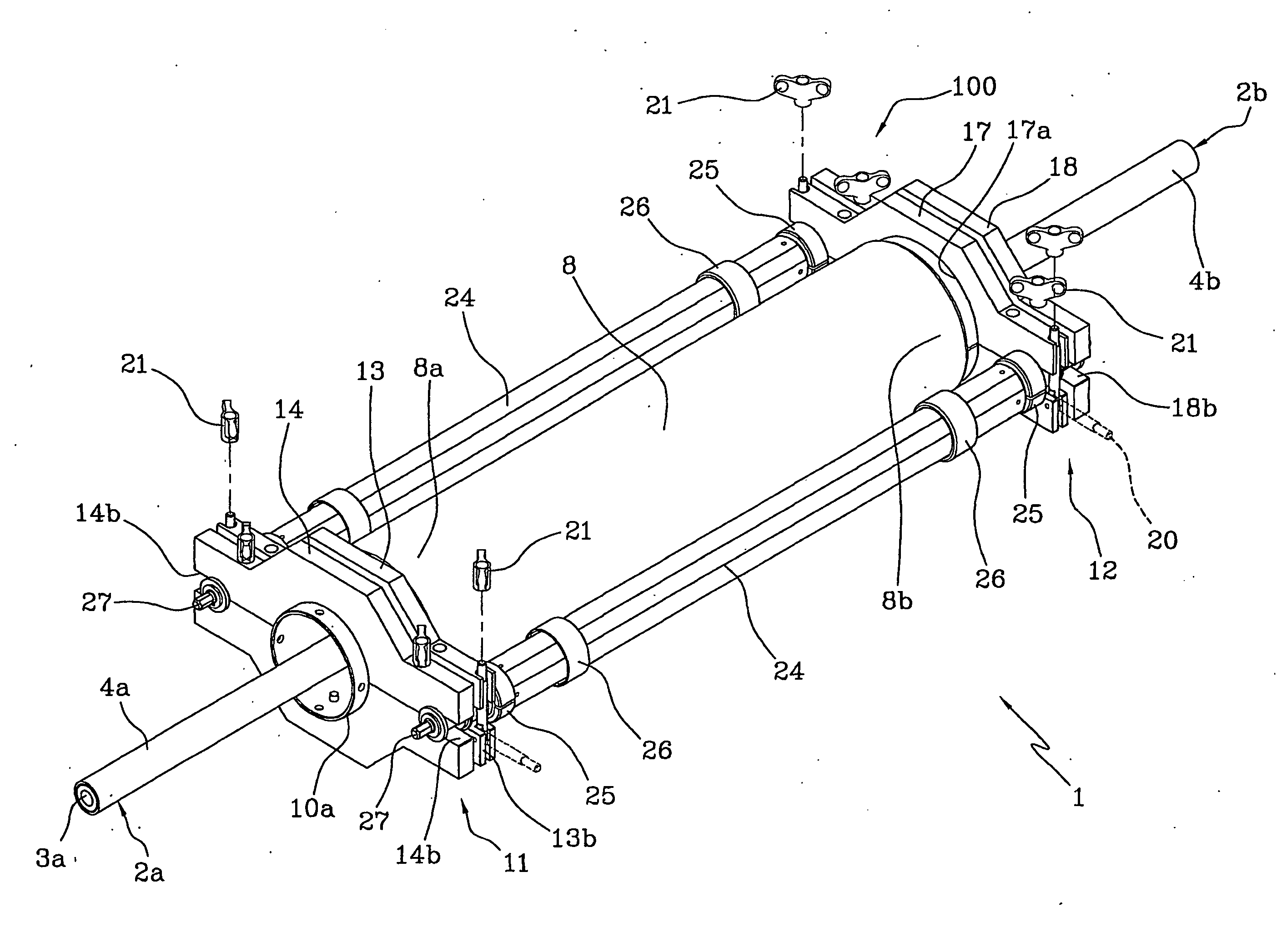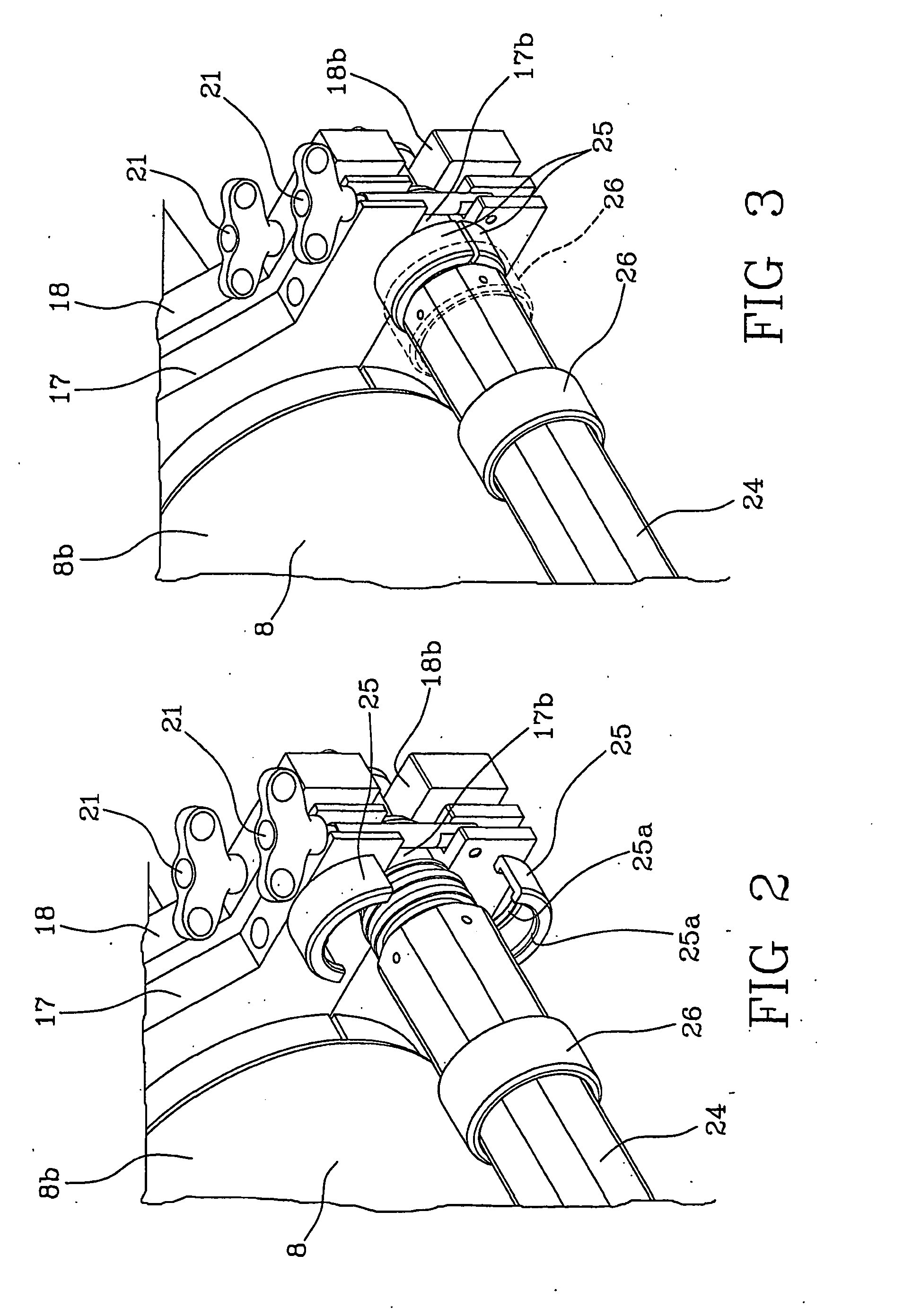[0030]Therefore, in one aspect, the present invention relates to a method of splicing at least one pair of cables, each cable including at least one conductor, said method comprising the steps of: setting a elastic tubular sleeve supported in a radially expanded condition on at least one supporting element; disposing the sleeve, in engagement with said supporting element, in a substantially coaxial position around one of said cables; connecting each conductor of said at least one pair of cables to obtain a splicing region between these cables; positioning the sleeve in engagement with the supporting element around the splicing region; axially moving the supporting element relative to the tubular sleeve, so as to cause a radial elastic shrinkage of the tubular sleeve capable of inducing an axial ejection thrust on the supporting element itself; counteracting the axial ejection thrust induced by the elastic shrinkage of the tubular sleeve; and adjusting the axial movement speed of the supporting element so as to adapt it to the elastic shrinkage speed of the tubular sleeve.
[0032]In addition, the method of the present invention is particularly advantageous because it is not affected by the
environmental temperature present at the moment of the installation. In fact, an important lowering of the
environmental temperature (above all when said temperature goes down under about 10° C.) causes a reduction often of great amount, in the shrinkage speed of the tubular sleeve relative to the ejection speed of the support, this fact involving a greater risk as regards formation of the above mentioned air pockets.
[0033]Furthermore, the method in accordance with the present invention enables the risks of jamming or locking of the supporting element during axial sliding of the latter to be avoided or at least greatly reduced, above all in the starting ejection step, in the absence of axial forces imposing a correct sliding to the supporting element within the elastic tubular sleeve. In fact, since the method of the present invention allows a precise and uniform control of the ejection speed of the supporting element, a possible jamming during the elastic shrinkage step of the tubular sleeve is advantageously averted.
[0034]In addition, by the method of the present invention use of lubricating materials that are usually placed at the interface between the elastic tubular sleeve and the supporting element to promote ejection of said supporting element is reduced. As above said, said lubricating materials can give rise to contact irregularities at the sleeve / spliced cables interface and / or promote entrapping of air particles between the inner surface of the elastic sleeve and the underlying cables. Furthermore, where the sleeves are submitted to long storage periods, said lubricating materials can gradually escape from the sleeve and / or be submitted to qualitative decay and, as a result, to a
partial loss of their lubricating function. Since the method of the present invention allows the ejection speed of the supporting element to be adjusted so as to adapt it to the elastic shrinkage speed of the tubular sleeve, the amount of lubricating material can be advantageously reduced as compared with the self-ejecting systems of the known art. In fact, in a self-ejecting
system use of a rather high amount of lubricating material is convenient, which material is interposed between the supporting element and the tubular sleeve, for the purpose of ensuring a full implementation of said ejection. In compliance with the present invention, on the contrary, it is sufficient to ensure the only amount of lubricating material that is strictly indispensable to avoid friction between the supporting element and the sleeve being so strong that the sleeve itself is deteriorated, as the ejection action does not rely on the lubricating material but on the axial movement of the supporting element relative to the sleeve, which movement is directly controlled from the outside.
[0035]The method of the present invention enables the above mentioned drawbacks to be overcome due to adjustment of the ejection speed of the supporting element relative to the shrinkage speed of the sleeve on the underlying spliced cables. In particular, the method of the present invention comprises the step of driving ejection of the supporting element by application of a pulling force oriented in an axial direction and applied to at least one end of the supporting element projecting externally of the elastic tubular sleeve. In this way, the method of the present invention enables a correct ejection of the supporting element to be ensured in a substantial absence of jamming actions both in the starting ejection step and during separation from the elastic tubular sleeve, which jamming actions are caused by friction generated by the sleeve elastically expanded on the supporting element.
 Login to View More
Login to View More 


